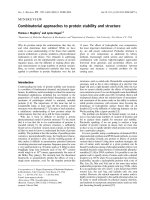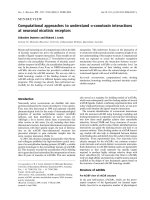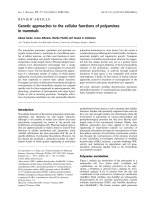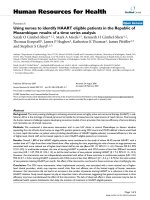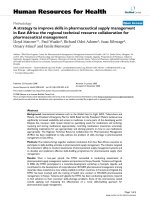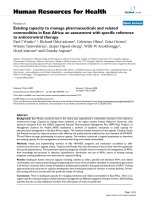Báo cáo sinh học: "ECM approaches to heteroskedastic mixed models with constant variance ratios" docx
Bạn đang xem bản rút gọn của tài liệu. Xem và tải ngay bản đầy đủ của tài liệu tại đây (846.71 KB, 22 trang )
Original
article
ECM
approaches
to
heteroskedastic
mixed
models
with
constant
variance
ratios
JL
Foulley
Station
de
génétique
quantitative
et
appliquée,
Institut
national
de
la
recherche
agronomique,
78352
Jouy-en-Josas
cedex,
France
(Received
6
February
1997;
accepted
28
May
1997)
Summary -
This
paper
presents
techniques
of
parameter
estimation
in
heteroskedastic
mixed
models
having
constant
variance
ratios
and
heterogeneous
log
residual
variances
that
are
described
by
a
linear
model.
Estimation
of
dispersion
parameters
is
by
standard
(ML)
and
residual
(REML)
maximum
likelihood.
Estimating
equations
are
derived
using
the
expectation-conditional
maximization
(ECM)
algorithm
and
simplified
versions
of
it
(gradient
ECM).
Direct
and
indirect
approaches
are
proposed
with
the
latter
allowing
hypothesis
testing
about
the
variance
ratios.
The
analysis
of
a
small
example
is
outlined
to
illustrate
the
theory.
heteroskedasticity
/
mixed
model / maximum
likelihood
/
EM
algorithm
Résumé -
Approches
ECM
des
modèles
mixtes
hétéroscédastiques
à
rapports
de
variances
constants.
Cet
article
présente
des
techniques
d’estimation
des
paramètres
intervenant
dans
des
modèles
mixtes
ayant
des
rapports
de
variance
constants
et
des
variances
résiduelles
décrites
par
un
modèle
linéaire
de
leurs
logarithmes.
Les
paramètres
de
dispersion
sont
estimés
par
le
maximum
de
vraisemblance
classique
(ML)
et
restreint
(REML).
Les
équations
à
résoudre
pour
obtenir
ces
estimations
sont
établies
à
partir
de
l’algorithme
d’espérance-maximisation
conditionnelle
(ECM)
et
d’une
version
simplifiée
dite
du
gradient
ECM.
Des
approches
directe
et
indirecte
sont
proposées,
cette
dernière
conduisant
à
un
test
d’hypothèse
sur
le
rapport
de
variances.
La
théorie
est
illustrée
par
l’analyse
numérique
d’un
petit
exemple.
hétéroscédasticité
/
modèle
mixte
/
maximum
de
vraisemblance
/
algorithme
EM
INTRODUCTION
Heteroskedasticity
has
recently
generated
much
interest
in
quantitative
genetics
and
animal
breeding.
To
begin
with,
there
is
now
a
large
amount
of
experimental
evidence
of
heterogeneous
variances
for
most
important
livestock
production
traits
(Garrick
et
al,
1989;
Visscher
et
al,
1991;
Visscher
and
Hill,
1992).
Second,
major
theoretical
and
applied
work
has
been
carried
out
for
estimating
and
testing
sources
of
heterogeneous
variances
arising
in
univariate
mixed
models
(Foulley
et
al,
1990;
Gianola
et
al,
1992;
Weigel
et
al,
1993;
DeStefano,
1994;
Foulley
and
Quaas,
1995).
For
many
reasons
(accuracy
of
estimation,
ease
of
handling
large
data
sets),
a
major
objective
in
this
area
lies
in
making
models
as
parsimonious
as
possible.
This
can
be
accomplished
in
at
least
two
ways:
i)
by
modelling
variances
in
the
case
of
potentially
numerous
sources
of
heteroskedasticity,
and
ii)
by
assuming
that
some
functions
of
those
parameters
(eg,
intra-class
correlation
or
heritability)
are
constant.
The
first
aspect
corresponds
to
the
so-called
structural
approach
in
which
the
heterogeneity
of
the
log
components
of
variances
is
described
via
a
linear
model
structure
similar
to
that
used
for
means
(Foulley
et
al;
1990,
1992;
San
Cristobal,
1993).
Restrictions
as
in
ii)
were
considered
by
Meuwissen
et
al
(1996)
and
Robert
et
al
(1995a,b).
Meuwissen
et
al
(1996)
introduced
a
multiplicative
mixed
model
to
estimate
breeding
values
and
heteroskedasticity
factors
assuming
heritability
(h
2)
constant
across
herd-years.
Robert
et
al
(1995a,b)
developed
estimation
and
testing
procedures
for
homogeneity
of
heritability
within
and/or
genetic
correlations
across
environments.
But
Meuwissen’s
study
postulates
known
h2
and
Robert’s
research
applies
to
only
a
single
classification
of
heteroskedasticity.
The
purpose
of
this
paper
is
to
propose
a
complete
inference
approach
for
parameters
having
both
features
i)
and
ii),
ie,
for
continuous
data
described
by
mixed
models
with
constant
variance
ratios
and
heteroskedasticity
analyzed
via
a
structural
approach.
For
simplicity,
the
theory
will
be
presented
using
a
one-
way
random
mixed
model
for
data
and
afterwards
it
will
be
generalized
to
several
u-components.
Inference
is
based
on
likelihood
procedures
(REML
and
ML)
and
estimating
equations
derived
from
the
expectation-maximization
(EM)
theory,
more
precisely
the
expectation/conditional
maximization
(ECM)
algorithm
recently
introduced
by
Meng
and
Rubin
(1993).
THEORY
Statistical
model
As
usual,
it
is
assumed
that
the
population
can
be
structured
into
strata
(i
=
1, 2, ,1)
corresponding
to
potential
factors
of
heterogeneity.
Let
the
one-way
random
model
be
written
as:
where
yi
is
the
(n
2
x
1)
data
vector
for
stratum
i;
j3
is
a
(p
x
1)
vector
of
unknown
fixed
effects
with
incidence
matrix
Xi,
and
ei
is
the
(n
i
x
1)
vector
of
residuals.
The
contribution
of
random
effects
is
expressed
as
in
Foulley
and
Quaas
(1995)
as
O&dquo;uiZiU’
where
u*
is
a
(q
x
1)
vector
of
standardized
deviations,
Zi
is
the
corresponding
incidence
matrix
and
au,
is
the
square
root
of
the
u-component
of
variance
the
value
of
which
depends
on
stratum
i.
Classical
assumptions
are
made
for
the
distributions
of
u*
and
ei,
ie,
u* N
N(0, A),
ei N
N(0, ae.In! ),
and
The
notation
in
[1]
is
unusual
as
compared
to
that
used
in
the
statistical
literature
on
mixed
effects
(eg,
Laird
et
al,
1987).
There
are
practical
motivations
for
such
an
expression
of
the
random
part
especially
in
animal
breeding.
For
instance
the
between
sire
variance
may
vary
according
to
the
environment
in
which
the
progeny
of
the
sires
are
raised.
Note
also
that
(J
Ui
can
be viewed
as
a
regression
coefficient
of
any
element
of
yi
on
the
corresponding
element
of
Ziu*.
Thus,
in
animal
breeding,
au,
acts
as
a
scaling
factor
of
a
vector
u*
of
standardized
sire
values
on
which,
for
instance,
selection
can
be
based.
A
structure
is
hypothesized
on
the
residual
variance
so
as
to
model
the
influence
of
factors
causing
heteroskedasticity.
This
is
carried
out
along
the
lines
presented
in
Foulley
et
al
(1990,
1992)
via
a
linear
regression
on
log-variances:
where
5
is
an
unknown
(r
x
1)
real-valued
vector
of
parameters
and
p’
is
the
corresponding
(1
x
r)
row
incidence
vector
of
qualitative
or
continuous
covariates.
Furthermore,
the
assumption
of
a
constant
intra-class
correlation
(or
heritability)
implies
setting
EM-REML
estimation
Use
is
made
here
of
the
EM
algorithm
of
Dempster
et
al
(1977)
to
compute
REML
estimates
of
parameters
involved
in
variance
components
(Patterson
and
Thompson,
1971;
Searle
et
al,
1992).
The
basic
procedure
proposed
by
Foulley
and
Quaas
(1995)
is
applied
here
after
some
adjustment
of
the
M-step
taking
advantage
of
the
ECM
algorithm
of
Meng
and
Rubin
(1993).
-
the
ECM
algorithm
is
based
on
a
complete
data
set
defined
by
x
=
(0’, u
*
’,
e’)’
and
its
log-likelihood
L(y; x).
The
iterative
process
takes
place
as
follows.
The
E-step
is
defined
as
usual,
ie,
at
iteration
[t],
calculate
the
conditional
expectation
of
L(y;
x)
given
the
data
y
and
y
=
y!t!
which,
as
shown
in
Foulley
and
Quaas
(1995),
reduces
to
where
E!t]
(.)
is
a
condensed
notation
for
a
conditional
expectation
taken
with
respect
to
the
distribution
of
x!y, y
=
-yf
t
l.
Since
the
parameters
to
be
estimated
are
heterogeneous,
the
estimating
equations
are
derived
at
the
maximization
stage
from
a
slightly
different
version
of
the
EM
algorithm,
the
so-called
ECM
algorithm.
As
explained
in
detail
in
Meng
and
Rubin
(1993),
a
CM
stage
replaces
the
M-step
by
a
sequence
of
several
conditional
maximization
steps.
This
is
basically
the
same
principle
as
that
employed
in
a
cyclic
ascent
maximization
procedure
(Zangwill,
1969).
We
suggest
here
the
following
procedure:
-
maximize
Q
over
y
to
get
6
[tH]
with
T
set
at
its
last
value
T
[t]
,
ie
-
then,
maximize
Q
over
T
to obtain
T!’+’l
with
5
in
y
of
Q(
1’I
1’[
t
])
set
to
5!!!,
ie,
Thus,
the
maximization
step
consists
of
two
CM-steps
within
the
same
E-step
in
order
to
reduce
the
need
to
compute
the
conditional
expectation
of
eie
i,
and
its
components
more
than
once.
The
algebra
of
differentiation
is
given
in
Appendix
A.
The
iterative
system
for
computing
formulae
5
can
be
written
as
with
the
elements
of
the
right-hand
side
being
Note
that
for
this
algorithm
to
be
a
true
ECM,
one
would
have
to
iterate
the
NR
algorithm
in
[7]
within
an
inner
cycle
(index
£)
until
convergence
to
the
conditional
maximizer
y[
tH]
=
yl’,’]
at
each
M-step
[t].
In
practice
it
may
be
advantageous
to
reduce
the
number
of
inner
iterations,
even
up
to
only
one,
ie,
by
solving
just
once
However,
caution
should
be
exercised
when
applying
such
a
hybrid
algorithm
that
no
longer
guarantees
the
monotonic
convergence
in
likelihood
values
(Lange,
1995).
The
formula
to
update
T
reduces
to
mimicking
the
form
of
a
scaled
regression
coefficient
pooled
over
strata.
The
elements
to
compute
at
the
E-step
can
be
expressed
as
functions
of
the
sums
X’yi,
Z’yi,
the
sums
of
squares
yiyi
within
strata,
and
GLS-BLUP
solutions
of
Henderson’s
mixed
model
equations
and
of
their
accuracy
(Henderson,
1984),
ie
Thus,
deleting
[t]
for
the
sake
of
simplicity,
one
has:
where
(3 and
u*
are
mixed
model
equations
for
13
and
u*,
and
C - _
[Cf
3f
3
Cf3u]
J
Cuf3
Cuu
is
the
partitioned
inverse
of
the
coefficient
matrix.
Expressions
in
[12a-c]
can
easily
accommodate
grouped
data
(see
Appendix
B).
The
close
connection
between
the
system
of
equations
[7]
for
residual
parameters
and
formula
[12]
given
in
Foulley
et
al
(1990)
can
be
observed.
There
is
also
a
remarkable
similarity
between
formula
[9]
for
the
ratio
and
formula
[7]
in
Foulley
and
Quaas
(1995).
This
means
that
the
computations
can
be
implemented
with
very
little
change
in
the
code
used
previously.
True
or
gradient
EM
could
also
have
been
applied
(see
Appendix
A).
The
advantage
of
ECM
will
be
more
substantial
for
the
next
situations
considered,
and
especially
in
the
case
of
the
indirect
approach.
Extension
to
several
u-components
Formulae
(7!,
[8ab]
and
[9]
can
easily
be
generalized
to
a
mixed model
including
several
(k
=
1,
2, ,
K)
independent
u-components
with
Tk
=
a
Uik
/aei
constant
over
strata
i.
Letting
y
=
(b’,
T
’)’
as
previously
but
now
with
T
=
I
Tk
being
a
vector
of
ratios
of
standard
deviations,
the
Q
function
to
be
maximized
has
the
same
form
as
in
[4]
with
ei
expressed
from
!13!.
One
can
perform
the
CM-steps
using
either
i)
the
sequence
6, ’r
l
, T
2
I
Tk
, - - - ,
TK,
ie,
each
Tk
one
by
one,
the
remaining
ones
being
held
constant,
or
ii)
the
sequence
/5,
and
T
as
a
whole
with
all
the
Tk
s
maximized
jointly.
In
both
cases,
the
algorithm
for
computing
5
is
formally
the
same
as
in
[7]
with
only
a
slight
change
in
the
definition
of
the
elements
of
W
bb
,
vb
being
unchanged
If
the
conditional
maximization
of
the T
ks
takes
place
one
by
one
(case
i),
formula
[9]
still
applies
for
each
of
them.
Otherwise
(case
ii),
one
has
to
solve
the
following
system:
An
indirect
approach
The
original
model
with
a
constant
T
ratio
specified
in
[1-3]
can
be
viewed
as
a
special
case
of
a
more
general
model
with,
as
previously,
fno, 2 -
p§5,
but
also
with
a
linear
structure
on
log-ratios
involving
either
the
same
(h
i
=
pi)
or
possibly
different
covariates.
Letting
y
=
(6’,
71’)’
here,
the
sequence
of
the
CM-steps
are
The
algorithm
for
S
is
the
same
as
in
[7].
The
algebra
for
A
is
shown
in
the
Appendix,
and
leads
to
a
system
that
can
be
written
under
a
similar
form
as
that
of
6
1 J
For
practical
reasons,
one
may
also
wish
to
limit
the
number
of
inner
iterations
(index
£)
even
to
only
one
in
order
to
reduce
the
volume
of
computation
but
the
application
of
this
ECM
gradient
algorithm
should
be
performed
carefully.
Further
empirical
simplifications
for
the
elements
of
[22]
can
be
proposed
along
the
same
lines
as
in
Foulley
et
al
(1990).
Again,
these
results
can
be extended
to
a
model
with
several
random
independent
factors
(k
=
1,
2, ,
K)
by
setting
Actually,
if
the
CM-steps
are
performed
for
each
vector
71
k
separately,
the
same
formulae
as
in
[20],
[21]
and
[22]
apply:
just
replace
Ti
,
Zi,
u*
by
Ti
,k,
Zi
k,
uk
and
ML
estimation
It
may
be
interesting
in
some
instances
to
use
ML
rather
than
REML
for
estimating
variance
components
(see
Discussion).
The
ECM
procedure
developed
in
this
paper
can
be
easily
adapted
to
obtain
ML
parameter
estimates.
13
is
now
part
of
the
parameter
vector
instead
of
being
a
vector
of
random
effects
with
infinite
variance
included
in
missing
data.
The
Q
function
to
be
maximized
has
the
same
formal
expression
as
in
[4]
but
here
at
the
E-step,
expectations
have
to
be
taken
with
respect
to
the
distribution
of
u*
given
y, y
=
y!t!,
and
13
=
13
[’I.
Maximization
with
respect
to
13
can
be
based
on
the
equation
<9Q/<9j3
=
0,
ie
One
can
proceed
as
previously,
ie,
run
two
CM-steps
for
the
dispersion
parameters
based
on
the
same
E-step
so
as
to
obtain
6!t+
and
T]
t+1
]
(or
!ft+1]),
and
then
perform
an
additional
CM-step
for
computing
¡3
[t+l]
based
on
!23!,
ie
l
&dquo;&dquo;
’
-!J
Alternatively,
it
may
be
advantageous
to
perform
the
CM-step
for
j3
and
the
next
E-step
jointly
by
solving
Henderson’s
mixed model
equations
in
I3
[Hl]
and
u*[
t+i]
=
E!u*!y,
61
tH
], rrl
tH])
based
on
6[Hl
]
and
Tfc+1
1.
Formulae
for
the
two
CM-steps
do
not
change.
The
only
additional
modification
results
from
taking
the
conditional
expectation
of
components
of
e!e,
given
y,
y =
y[
t
],13
=
l3
[t]
instead
of
y, y
=
y
[t]
.
Formulae
in
[12]
reduce
to
where
M
uu
is
the
u
by
u
block
of
the
coefficient
matrix
!11!.
Note
that
the
trace
terms
inside
those
formulae
have
disappeared
or
have
been
greatly
simplified
owing
to
conditioning
with
respect
to
(3
=
l3
[t]
.
More
generally,
for
models
[13]
involving
several
u-components,
[25c]
becomes
where
(M§) )
k£
is
the
block
pertaining
to
random
factors
k
and
in
the
inverse
of
the
random
part
of
the
coefficient
matrix.
Numerical
example
The
procedures
presented
in
this
paper
are
illustrated
with
a
small
data
set
obtained
from
simulation.
Data
were
generated
according
to
a
cross-classified
model
having
two
(environmental)
fixed
factors
(A =
2 levels;
B
=
3
levels)
and
one
(genetic)
random
factor
(S
=
9
levels).
The
genetic
contribution
consists
of
sire
and
maternal
grand
sire
effects,
the
latter
being
assumed
to
have
half
the
value
of
the
first
one.
The
model
to
generate
the
records
was
where
p
is
a
general
mean,
ai
the
effect
of
environmental
factor
A
(i
=
1, 2),
b!
the
effect
of
environmental
factor
B
(j
=
1, 2, 3),
s*
the
standardized
contribution
of
male
k as
a
sire,
and
1/2se
the
standardized
contribution
of
male
as
a
maternal
grand
sire,
and
eZ!w&dquo;,
the
residual
term.
Values
chosen
for
the
fixed
effects
were
(using
a
full-rank
parameterization):
¡ t
+al
+b1
=
100;
az-
on
=
20;
b2
- b,
=
-10;
b3 - bl
=
-20.
The
vector s
*
=
fs
*
kl
}
of
sire
effects
is
assumed
to
be
N(0,
A)
with
elements
of
the
relationship
matrix
A
shown
at
the
bottom
of
table
I.
Residual
variances
were
obtained
from
with
a
base
line
value
(]&dquo;!11
=
exp(p
*
+ai +bl)
=
400,
and
multiplicative
adjustment
factors:
exp(a2 -
a*)
=
2;
exp(b2 -
bi)
=
1/2
and
exp(b3 -
b*)
=
3/2.
The
ratio
T
=
(]
&dquo; 8ij
/ (]&dquo;
eij
of
the
square
root
of
the
sire
to
the
residual
variance
was
taken
as
constant
over
A
x
B
cells
and
set
to
8.75-
1/2
(heritability
equal
to
0.41).
There
were
267
observations
distributed
among
18
different
AB
x
sire x
maternal
grand
sire
subclasses.
The
data
structure
is
displayed
in
table
I
as
well
as
cell
size
(n),
sum
(£ y)
and
sum
of
squares
(¿ y
2)
in
each
suclass.
Tests
of
hypotheses
about
the
location
parameters
{3,
the
residual
dispersion
parameters
5
and
the
ratios
r
ij
were
carried
out
via
the
likelihood
ratio
statistic
as
described
in
previous
studies
(Foulley
et
al,
1990
1992;
San
Cristobal
et
al,
1993;
Meyer
et
al,
1993;
Foulley
and
Quaas,
1995).
Formulae
by
Quaas
(1992)
were
used
to
compute
maximized
likelihood
functions
(Ln,
aX).
Results
can
be
arranged
as
an
analysis
of
variance
(or
deviance)
table:
see
table
II
for
hypothesis
testing
about
{3,
and
table
III
for
residual
(b)
and
ratio
(A)
parameters.
Note
also
that
the
test
statistic
for
13
relies
on
-2L
n
,aX
evaluated
from
the
ML
estimates
of
all
parameters,
whereas
a
maximized
residual
likelihood
can
be
better
employed
for
5
and
7!.
Interaction
effects
on
location
parameters
are
constantly
rejected
under
different
assumptions
for
the
other
parameters.
The
hypothesis
of
residual
variance
homo-
geneity
is
strongly
rejected
as
well
as
single
factor
descriptions
of
heterogenity.
The
assumption
of
a
constant
ratio
T
turns
out
to
be
a
reasonable
one.
The
test
results
eventually
agree
with
the
simulation
model;
they
support
the
practical
conclusion
that
the
p
+
A
+
B
model
is
the
most
appropriate
to
account
for
variation
both
in
location
and
in
log-residual
variances,
the
ratio
T
being
constant.
The
estimation
procedure
for
l5
and
T
(or
J!)
is
illustrated
in
table
IV
for
this
model
and
an
alternative
one
using
both
standard
and
residual
maximum
likelihood
methods
of
estimation.
ML
and
REML
estimates
of
residual
variances
do
not
differ
very
much;
on
the
contrary,
the
ML
estimates
of
the
ratio
T
turns
out
to
be,
as
expected,
lower
than
the
REML
ones,
the
values
of
the
latter
being
close
to
the
true
value.
DISCUSSION
AND
CONCLUSION
The
main
purpose
of
this
paper
was
to
extend
the
general
structural
approach
to
heteroskedasticity
in
mixed
models
proposed
by
Foulley
et
al
(1990,
1992)
to
the
case
of
homogeneous
ratios
of
u
to
e
variance
components.
In
a
sire
by
environment
interaction,
this
is
equivalent
to
postulating
homo-
geneous
intra-class
correlations
or
heritabilities.
This
seems
to
be
a
reasonable
assumption
in
practice,
or
at
least
serves
as
a
suitable
compromise
between
the
existence
of
heteroskedasticity
and
parsimony
of
models.
Less
restrictive
assump-
tions
might
also
be
investigated
(Quaas,
1995,
pers
comm).
This
paper
also
provides
a
generalization
of
LR
tests
of
this
assumption
to
unbalanced
data
and
complex
model
structures:
see
the
previous
work
of
Visscher
(1992)
on
a
one-way
random
balanced
design,
and
that
by
Robert
et
al
(1995a,b)
for
heterogeneous
variances
due
to
a
single
classification.
The
EM
algorithm
turns
out
to
be
a
convenient
and
powerful
tool
for
solving
variance
component
estimation
problems.
The
ECM
algorithm
allows
us
to
simplify
the
estimating
equations,
in
particular
the
ECM
gradient
version.
The
advantage
of
this
algorithm
was
especially
clear
here
in
the
case
of
the
indirect
approach.
A
few
examples
of
this
for
the
mixed
model
have
been
already
mentioned
(Meng
and
Rubin,
1993
example
1;
Walker,
1996).
It
offers
great
flexibility
in
defining
the
sequence
of
the
conditional
maximization
steps,
all
the
alternatives
of
which
have
not
been
investigated
here.
In
the
case
addressed
in
this
paper,
the
basic
statistics
by
the
EM
algorithm
are
strikingly
natural
(see
Appendix
B)
thus
giving
a
flavour
of
simplicity
to
the
whole
procedure.
It
also
makes
it
possible
to
switch
from
REML
to
ML
or
vice
versa
with
very
little
change
in
implementing
computations
(Foulley
et
al,
1994).
Some
authors
such
as
Leonard
(1975),
Denis
(1983)
and
Anderson
(1984)
in
statistics
and
Shaw
(1987)
in
quantitative
genetics
have advocated
the
use
of
ML
rather
than
REML
procedures
to
estimate
variance
components.
Although
the
interest
of
ML
versus
REML
in
that
case
remains
questionable,
ML
estimates
remain
mandatory
for
hypothesis
testing
about
13
via
the
LR
statistic
(see
the
numerical
example).
Bayesian
point
estimators
can
also
be
envisioned
via
EM
(Foulley
et
al,
1992;
Gianola
et
al,
1992;
San
Cristobal
et
al,
1993;
Weigel
and
Gianola,
1993;
Foulley
and
Quaas,
1995).
In
addition,
as
already
pointed
out
by
Denis
et
al
(1996),
a
LR
test
about
(3
requires
5
and T
(or
71)
being
the
same
for
the
null
hypothesis
and
its
alternative;
the
same
rule
holds
in
hypothesis
testing
about
5
(or
71)
by
keeping
the
other
parameters
the
same
over
the
models
to
be
compared.
This
is
part
of
the
general
and
difficult
problem
of
joint
modelling
of
means
and
variances,
which
is
related
to
such
issues
as
the
Behrens-Fisher
problem
and
multi-stage
hypothesis
testing,
and
which
needs
further
consideration.
Another
area
that
deserves
caution
and
further
development
is
that
of
estima-
bility.
Difficulties
are
expected
when
all
the
cells
contributing
to
an
element j
of
5
or
A
(or
to
a
linear
combination
of
them)
have
a
weight
tending
towards
zero.
This
may
arise
due
to
i)
purely
overparameterization
problems,
or
due
to
ii)
pa-
rameter
values
becoming
extreme
(eg,
ratios
Ti
tending
to
zero
implying
elements
of
71
being
infinite).
This
last
phenomenon
is
similar
to
what
happens
in
the
anal-
ysis
of
binary
and
ordinal
data
with
latent
variable
models
(Misztal
et
al,
1989;
Fahrmeir
and
Tutz,
1994).
Such
difficulties
can
be
avoided
by
reparameterization
(i),
or
by
setting
lower
bounds
to
the
diagonal
elements
of
the
system
of
equations
to
solve
(ii).
Finally,
asymptotic
accuracy
can
also
be
worked
out
numerically
within
the
EM
framework
via
the
so-called
SEM
algorithm
(Meng
and
Rubin,
1991).
Although
it
only
requires
the
code
of
the
complete
data
variance
covariance
matrix
and
of
the
EM
or
ECM
outputs,
the
burden
of
calculations
is
then
heavier,
so
that
we
suggest
that
it
is
restricted
to
the
simplest
models.
Other
computing
alternatives
should
also
be
considered,
eg,
the
average
information-restricted
maximum
likelihood
algorithm
(AI-REML)
of
Gilmour
et
al
(1995).
ACKNOWLEDGMENTS
The
author
is
grateful
to
Elinor
Thompson
(INRA,
Jouy-en-Josas)
and
Dr
Max
Rothschild
(ISU,
Ames)
for
the
English
revision
of
the
manuscript
and
to
the
two
anonymous
referees
for
their
valuable
comments
especially
about
some
technicalities
of
the
EM
theory.
REFERENCES
.
Anderson
TW
(1984)
An
Introduction
to
Multivariate
Statistical
Analysis.
J
Wiley
and
Sons,
New
York
Dempster
AP,
Laird
NM,
Rubin
DB
(1977)
Maximum
likelihood
from
incomplete
data
via
the
EM
algorithm.
J
R
Statist
Soc
B
39,
1-38
Denis
JB
(1983)
Extension
du
mod6le
additif
d’analyse
de
variance
par
modélisation
multiplicative
des
variances.
Biometrics
39,
849-856
Denis
JB,
Piepho
HP,
van
Eeuwijk
A
(1996)
Mixed
models
for
genotype
by
environment
tables
with
an
emphasis
on
heteroskedasticity.
Technical
Report,
Laboratoire
de
Biom6trie
DeStefano
AL
(1994)
Identifying
and
quantifying
sources
of
heterogeneous
residual
and
sire
variances
in
dairy
production
data.
PhD
thesis,
Cornell
University,
Ithaca,
New
York
Fahrmeir
L,
Tutz
G
(1994)
Multivariate
Statistical
Modelling
Based
on
Generalized
Linear
Models.
Springer
Verlag,
Berlin
Foulley
JL,
Gianola
D,
San
Cristobal
M,
Im
S
(1990)
A
method
for
assessing
extent
and
sources
of
heterogeneity
of residual
variances
in
mixed
linear
models.
J
Dairy
Sci
73,
1612-1624
Foulley
JL,
San
Cristobal
M,
Gianola
D,
Im
S
(1992)
Marginal
likelihood
and
Bayesian
approaches
to
the
analysis
of
heterogeneous
residual
variances
in
mixed
linear
Gaussian
models.
Comput
Stat
Data
Anal
13,
291-305
Foulley
JL,
H6bert
D,
Quaas
RL
(1994)
Inferences
on
homogeneity
of
between
family
components
of
variance
and
covariance
among
environments
in
balanced
cross-classified
designs.
Genet
Sel
Evol 26,
117-136
Foulley
JL,
Quaas
RL
(1995)
Heterogeneous
variances
in
Gaussian
linear
mixed
models.
Genet
Sel
Evol 27,
211-228
Garrick
DJ,
Pollak
EJ,
Quaas
RL,
Van
Vleck
LD
(1989)
Variance
heterogeneity
in
direct
and
maternal
weight
traits
by
sex
and
percent
purebred
for
Simmental
sired
calves.
J
Anim
Sci
67,
2515-2528
Gianola
D,
Foulley
JL,
Fernando
RL,
Henderson
CR,
Weigel
KA
(1992)
Estimation
of
heterogeneous
variances
using
empirical
Bayes
methods:
theoretical
considerations.
J
Dairy
Sci
75,
2805-2823
Gilmour
AR,
Thompson
R,
Cullis
BR
(1995)
Average
information
REML:
an
efficient
algorithm
for
variance
parameter
estimation
in
linear
mixed
models.
Biometrics
51,
1440-1450
Henderson
CR
(1984)
Applications
of
Linear
Models
in
Animal
Breeding.
University
of
Guelph, Guelph,
Ontario,
Canada.
Lange
K
(1995)
A
gradient
algorithm
locally
equivalent
to
the
EM
algorithm.
J
R
Statist
Soc
B
57,
425-437
Laird
NM,
Lange
N,
Stram
D
(1987)
Maximum
likelihood
computations
with
repeated
measures:
application
to
the
EM
algorithm.
J
Am
Statist
Assoc
82, 97-105
Leonard
T
(1975)
A
Bayesian
approach
to
the
linear
model
with
unequal
variances.
Technometrics
17,
95-102
Meuwissen
THE,
De
Jong
G,
Engel
B
(1996)
Joint
estimation
of
breeding
values
and
heterogeneous
variances
of
large
data
files.
J
Dairy
Sci
79,
310-316
Misztal
I,
Gianola
D,
Foulley
JL
(1989)
Computing
aspects
of
a
non
linear
method
of
sire
evaluation
for
categorical
data.
J
Dairy
Sci
72,
1557-1568
Meng
XL.,
Rubin
DB
(1991)
Using
EM
to
obtain
asymptotic
variance-covariance
matrices:
the
SEM
algorithm.
J
Am
Stat
Assoc
86,
899-909
Meng
XL,
Rubin
DB
(1993)
Maximum
likelihood
estimation
via
the
ECM
algorithm:
A
general
framework.
Biometrika
80,
267-278
Meyer
K,
Carrick
J,
Donnelly
BJP
(1993)
Genetic
parameters
for
growth
traits
of
Australian
beef
cattle
from
a
multibreed
selection
experiment.
J
Anim
Sci
71,
2614-
2622
Patterson
HD,
Thompson
R
(1971)
Recovery
of
interblock
information
when
block
sizes
are
unequal.
Biometrika
58,
545-554
Quaas
RL
(1992)
RL.
REML
Note
book,
Mimeo,
Cornell
University,
Ithaca,
New
York
Robert
C,
Foulley
JL,
Ducrocq
V
(1995a)
Inference
on
homogeneity
of
intra-class
corre-
lations
among
environments
using
heteroskedastic
models.
Genet
Sel
Evol
27,
51-65
Robert
C,
Foulley
JL,
Ducrocq
V
(1995b)
Estimation
and
testing
of
constant
genetic
and
intra-class
correlation
coefficients
among
environments.
Genet
Sel
Evol
27,
125-134
San
Cristobal
M,
Foulley
JL,
Manfredi
E
(1993)
Inference
about
multiplicative
het-
eroskedastic
components
of
variance
in
a
mixed
linear
Gaussian
model
with
an
ap-
plication
to
beef
cattle
breeding.
Genet
Sel
Evol
25,
3-30
Searle
SR,
Casella
G,
McCulloch
CE
(1992)
Variance
Components.
J
Wiley
and
Sons,
New-York
Shaw
RG
(1987)
Maximum
likelihood
approaches
applied
to
quantitative
genetics
of
natural
populations.
Evolution
45,
143-151
Visscher
PM
(1992)
On
the
power
of
likelihood
ratio
tests
for
detecting
heterogeneity
of
intra-class
correlations
and
variances
in
balanced
half-sib
designs.
J
Dairy
Sci
75,
1320-1330
Visscher
PM,
Thompson
R,
Hill
WG
(1991)
Estimation
of
genetic
and
environmental
variances
for
fat
yield
in
individual
herds
and
an
investigation
into
heterogeneity
of
variance
between
herds.
Livest
Prod
Sci
28,
273-290
Visscher
PM,
Hill
WG
(1992)
Heterogeneity
of
variance
and
dairy
cattle
breeding.
Anim
Prod
55, 321-329
Walker
S
(1996)
An
EM
algorithm
for
non
linear
random
effects
model.
Biometrics
52,
934-944
Weigel
KA,
Gianola
D
(1993)
A
computationally
simple
Bayesian
method
for
estimation
of
heterogeneous
within-herd
phenotypic
variances.
J
Dairy
Sci
76,
1455-1465
Weigel
KA,
Gianola
D,
Yandel
BS,
Keown
JF
(1993)
Identification
of
factors
causing
heterogeneous
within-herd
variance
components
using
a
structural
model
for
variances.
J
Dairy
Sci
76,
1466-1478
Zangwill
W
(1969)
Non
Linear
Programming:
A
Unified
Approach.
Prentice
Hall,
Engle-
wood
Cliffs
APPENDIX
A:
Algebra
for
the
estimating
equations
The
Q
function
to
be
maximized
is
(in
condensed
notation)
Derivatives
with
respect
to
b
(residual
dispersion
parameters)
First
derivatives:
according
to
the
chaining
rule,
one
has
Letting
!=<9(2Q)/<9 In
(y2 ei
Second
derivatives:
from
!A4a!,
one
has
Now,
using
[A4b]
or,
alternatively
Finally,
the
non-linear
system
to
solve
reduces
to
Derivatives
with
respect
to
T
(ratio)
The
equation
8Q/8T
=
0
results
in
Additional
derivatives
for
the
exact
EM
From
the
second
expression
in
[A7]
it
follows
immediately
One
has
also
to
express
Now,
from
[A7]
where
W r8
is
a
(I
x 1)
defined
by
The
system
for
true
EM
(or
gradient
EM
without
inner
iteractions)
is
then
Extension
to
K
independent
random
factors
Q
in
[Al]
remains
formally
unchanged
with
ei
in
[A3]
being
now
Based
on
this
expression
of
the
residual,
formulae
[A4ab]
still
hold.
Similarly,
the
expression
of
w
66
,
ii
in
[A5b]
becomes
or,
alternatively
As
far
as
T
is
concerned,
[A6]
becomes
leading
to
the
following
system
Derivatives
with
respect
to
7!
(parameters
of
the
log-ratio)
Q
and
the
model
for
In (
T e, 2
are
the
same
as
in
[Al]
and
[A2]
but
the
vector
of
residuals
is
defined
as
o
,
I
I
Using
condensed
notation,
the
iterative
system
to
solve
can
be
written
in
the
same
was
as
previously,
ie
or,
after
some
algebra
Furthermore,
This
can
be
easily
generalized
to
several
independent
random
factors
if
conditional
maximization
is
performed
factor
by
factor.
The
system
[AI8]
applies
to
each
factor
k
with
APPENDIX
B:
Formulae
[12]
for
grouped
data
In
some
instances
(see,
eg,
the
example
in
table
I)
data
can
be
grouped
so
that
the
n2
observations
within
a
stratum
i
share
the
same
covariates
where
x’
and
z’
are
the
common
row
vectors
(1
x
p)
and
(1
x
q)
pertaining
to
fixed
and
random
effects,
respectively.
Substituting
Xi
by
its
expression
in
[Bl]
gives
where
y
zj
is
the
jth
element
of
yi,
and
Similarly

